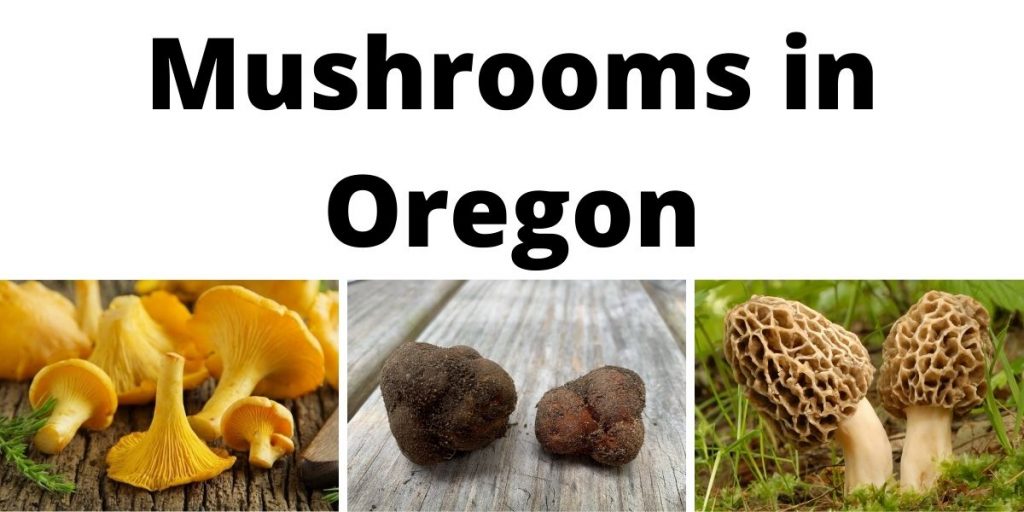Oregon is an interesting state to be a mycophile because the eastern and western parts of the state are so different—basically, there are two Oregons, and while it’s somewhat easier to find information about coastal Oregon’s options, there are mushrooms in both halves.
There is no way we can list every mushroom species, or even every edible mushroom species, in the state. There are way too many. What we can do is give you a small sampling of some of the most popular and interesting species.
Our Recommended Field Guides for Oregon
COVER | TITLE | Header | ||
|---|---|---|---|---|
OUR #1 RATED | ||||
Edible Wild Mushrooms in Oregon
Oregon boasts many edible mushrooms. Here are just a few. Please don’t go out and forage simply on our recommendation, though. In fact, if you’re a beginner, don’t go out foraging at all without a skilled guide (or at the minimum a field guide), better yet take spore prints. It’s not that mushrooms are especially hard to identify (at least, not in most cases), it’s that until you get really familiar with mushrooms you’re likely to overlook key details, so there’s much greater chance of a mistake. Get some experience, learn how to really see mushrooms, and then go foraging (be sure to take a basket and a proper knife when mushroom hunting!).
Dark Honey Mushroom (Armillaria solidipes)
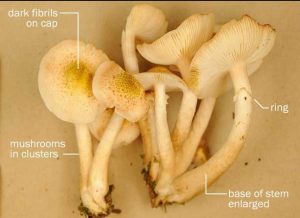
The largest known organism in the world, and one of the oldest, is a fungus in Oregon[i]. It’s often referred to as a “big mushroom” or a “giant underground mushroom,” but these descriptors are misleading—the fungus does produce mushrooms, but they aren’t especially large, nor are they underground. It’s the mycelium, the network of threads that form most of a fungus’ body, that is large and mostly underground or inside the trees it is busy killing and eating. The whole thing covers at least three square miles. It’s a member of the genus, Armillaria, the honey mushrooms, named for the color of their fruiting bodies, not their taste. Exactly which honey species this big one is not always clear in the various accounts, but many refer to it as A. solidipes or A. ostoya, a darker species than the yellow-brown A. mellea that originally inspired the name, honey mushroom.
Honeys eat trees and can be serious pests from the perspective of foresters, but they are themselves edible, at least for most people (as with many mushroom species, it will cause problems for some people)[ii].
Chanterelles (Cantharellus sp. and others)
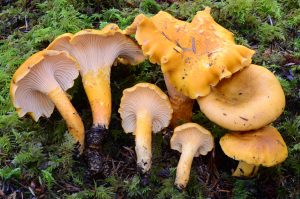

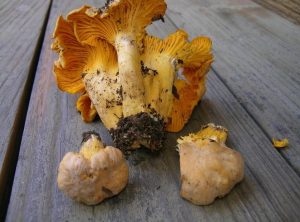
The Pacific golden chanterelle (C. formosus) is Oregon’s official state mushroom, probably because it is delicious and grows abundantly in many parts of the state[iii]. It is difficult to cultivate, so the wild harvest is commercially important. Chanterelles are funnel-shaped, with ridges, rather than gills, on their outer surface. Nine species in Oregon fit that description. Seven are edible.
Three are in the genus, Cantharellus, which is generally considered the chanterelle genus: the aforementioned Pacific golden, the similar White Chanterelle (C. subalbidus), and the rainbow chanterelle (C. roseocanus), which is orange, not rainbow-color. The other species belong to other genera, but are closely related and can loosely be called chanterelles, trumpets, or false chanterelles: Yellowfoot (Craterellus tubaeformis), Black Trumpet (Craterellus cornucopioides), Pig’s Ears (Gomphus clavatus), Blue Chanterelle (Polyozellus multiplex), and two woolly, possibly poisonous species, Turbinellus floccosus and Turninellus kauffmanii.
Western Giant Puffball (Calvatia booniana)
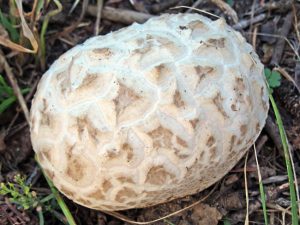
Giant puffballs live up to their names, sometimes reaching two feet across. Although the eastern species (C. gigantea) is somewhat better-known, the western giant[iv] is quite similar (except for a much more textured exterior), and is the one found in much of Oregon. Both are edible if harvested young, before the spores begin to develop, though the western species reportedly has a stronger (and not always pleasant) odor when drying. Puffballs as a group have an odd texture that not everybody enjoys, but dried they can be made into a powder and added to many recipes.
The shear size of the giant puffball is an excellent field mark, but a small specimen could be mixed up with a larger example of any of several other puffball species. In general, edible puffballs can also be confused with toxic Earthballs or even the “egg” stage of the deadly Amanita species, but the size of these giant mushrooms makes such confusion perhaps a little less likely.
King Bolete (Boletus sp.)
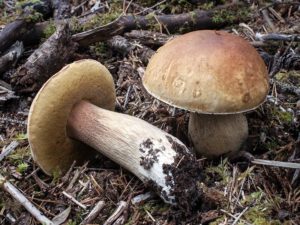
The King Bolete[v] is known by many names, including porcini and penny bun, in part because it is found in so very many places. And, like many mushrooms with a very broad range, it’s not really a single species but several, with the taxonomy not entirely worked out yet[vi]. Boletus edulis was the original collective name, but it’s difficult to say which name properly belongs to the Oregon version. It’s also worth noting that there are many other boletes, plus others that have been moved to new genera bu retain “bolete” as part of their name, that are not the king. Some of these others are edible, but some are not.
King Boletes are very popular edibles, thanks to their dense, meaty, almost crunchy texture and their pleasant, nutty flavor. They are good prepared virtually any way mushrooms can be prepared, though drying removes the hint of bitterness than can mar the flavor of some specimens. King bolete powder can be added to soups, sauces, and gravies, although a little goes a long way—it’s strong stuff!
Morels (Morchella sp.)
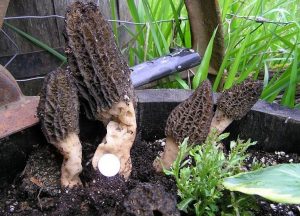

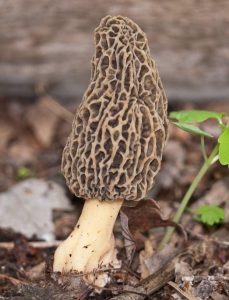
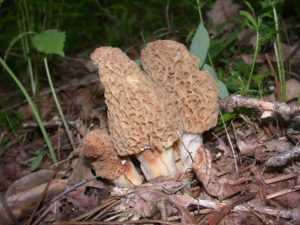
Morels combine great taste with the thrill of the hunt, popping up on unpredictable basis in the spring, usually in recently-burned areas of Oregon’s conifer forests. People who know where a good morel patch is are careful to never tell anyone else, since competition for these odd-looking mushrooms (the narrow cap is pitted like a honeycomb) can be fierce.
Most writers refer to Oregon’s morels simply as “morels,” as though that were the name of a species. It’s not. There are many species of morel, and several grow in Oregon. Common names sometimes don’t reflect true species distinctions—morels are variable, and some are hard to tell apart, so some common names refer to more than one species while other species have more than one common name. Scientifically speaking, Oregon’s morels include: M. importuna, M. snyderi, M. americana, and M. esculentoides[vii].
Psychedelic Magic Mushrooms in Oregon
Readers may have heard that psychoactive mushrooms have been legalized in Oregon. That both is and is not true[viii].
First of all, regardless of state law, psilocybin (and any mushrooms that contain it) is still against Federal law. That means in any circumstances under which the Federal government has jurisdiction, possession or use of psilocybin will remain a crime for the foreseeable future. Second, the new state law does not allow personal use at home. The law instead requires the creation of a set of rules whereby designated therapy centers will be allowed to supervise psilocybin use for either mental-health treatment or personal-growth purposes.
Picking a few mushrooms in the woods isn’t covered and is still illegal, but there are mushrooms in the woods. Here are a few of them, all Psilocybes[ix].
P. cyanescens

These mushrooms are slightly above average in terms of potency and easy to find in urban areas because they especially like to grow in wood chips.
P. azurescens
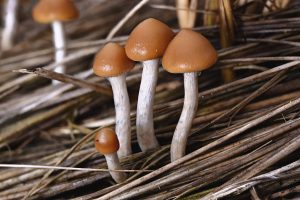
At least locally, these are called Oregon blues. They’re extremely potent. They often grow among dune grass.
P. stuntzii
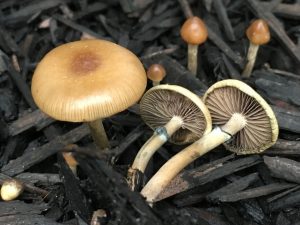
This one is a relatively new discovery, but it’s already accummulated multiple common names, imcluding blue ringer, Washington blue veil, and blue legs. It also looks even more like one of the deadly Galernas than most psychoactive shrooms do, so do be careful.
P. semilanceata

This is the famous liberty cap, one of the best-beloved Psilocybes after P. cubensis. They’re common in the region’s cow pastures.
P. pelliculosa and P. silvatica

These two are impossible to tell apart without a microscope, but that’s OK because they produce the same effect when eaten—their potency is relatively low, making mild trips or even microdosing convenient.
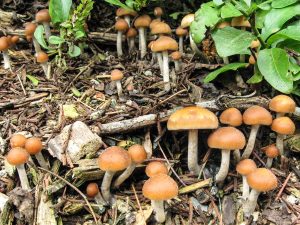
This one is new to science, having only been named in 2013. It’s relatively common, though, and considered moderately potent.
Poisonous Mushrooms in Oregon
There is no simple way to tell whether a mushroom is poisonous. Rules like “all mushrooms with white spores are poisonous” (some are, others aren’t) or “mushrooms growing on wood are safe” (might be true in Italy, but in North America will kill you) are worse than useless because there are always some species that don’t follow the rules. The only way to forage safely is to learn how to identify mushroom species and not to eat any whose identity is in doubt. It’s a good idea to learn the poisonous species as well as the edibles, since many edible mushrooms have poisonous look-alikes.
An introductory list of a few of the poisonous species in Oregon may help readers get started, but remember, there are lots of poisonous species not on the list.
Not all poisonous mushrooms are deadly. Many simply cause some degree of gastric upset. Many are poisonous sometimes but not others, and it’s not always clear why. Of those that can kill, many have toxins that work very slowly, meaning the victim might not feel bad for several days—and might even feel better again for a while after the initial symptoms pass. Then major organ failure begins. It’s important to take the possibility of mushroom-poisoning seriously, even if the mushroom was of a kind previously eaten with no ill effects or eaten several days earlier.
Little Brown Mushrooms (LBMs)
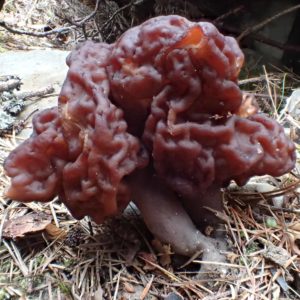
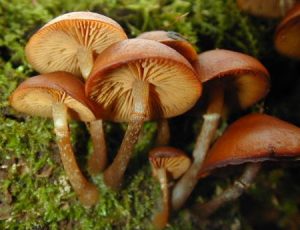
“LBM” is an acronym for “little brown mushroom,” a very large group of very similar-looking, mostly unrelated, species. The big problem is that while most magic mushrooms are LBMs, so are several species that can kill people who eat them. It is not a good idea to allow wishful thinking to bias the identification process, nor should psychonauts who are not experienced foragers go picking wild magic because this mushroom over here looks like what’s growing in the fruiting chamber back home. There is no short-cut to learning mushroom identification, and LBMs are a big part of the reason why!
Oregon’s toxic LBMs include Pholiotina rugosa[x] and Galerina marginata[xi]. Both can kill adult humans. The Galerinas are especially common in Oregon, where they often grow alongside similar-looking edibles, such as honey mushrooms.
Deadly Amanitas
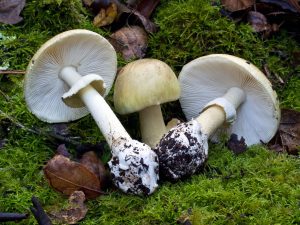
There are many species in the Amanita genus. Some are edible, and some can be safely used as psychedelics if processed properly first. Others can kill. Most writers recommend avoiding all Amanitas just in case, since it’s usually easier to tell that something is an Amanita than which Amanita it is. Experienced foragers can and do tell Amanitas apart, enjoying some and admiring others only from a distance, but mistakes are possible.
Most fatal mushroom poisonings in the world are attributed to the death cap, Amanita phalloides[xii], a species native to Europe but now spread all over the world, including to Oregon, on the roots of landscaping stock. In the Western United states, many of its victims are Asian immigrants because it resembles an edible species back home. In Oregon, it still grows mostly in developed areas.
Reportedly, Oregon is also home to the destroying angel mushroom, a related and likewise deadly Amanita. Unfortunately, that common name belongs to multiple species. It’s difficult to find a list of exactly which ones grow in Oregon. Most are large and all-white, whereas the death cap is pale, dull green and white.
False Morels

The false morels, mostly in the genus, Gyromitra, are a group that have wrinkled caps, rather than the pitted caps of true morels, meaning they look similar except on close inspection. Most are poisonous, though usually not deadly. Gyromitra esculenta is one of the strongest morel look-alikes. It is also both a popular edible in its own right and a known poisoner. The problem is that it, like many false morels, is only poisonous sometimes, meaning many people have eaten it without trouble—but eating one meal safely is no guarantee of safety for the next meal. Some writers insist there is no reason to avoid it at all, provided it is cooked properly in a well-ventilated area. Other writers are in favor of more caution.

My name is Austin Collins.
I've dedicated my life to Mushrooms.
I believe Mushrooms are the best kept secret when it comes to health and well being.
For that reason, I would like to share a company with you that in my opinion makes the best mushroom products on the market.
The company is called Noomadic Herbals, my favorite supplement they make is called "Mushroom Total".
I take their products every day and they have helped me think better and have more energy. Give them a try.
-Austin
References:
[i] Patton, V. (2015). Oregon Humongous Fungus Sets Record as Largest Single Living Organism on Earth. Oregon Public Broadcasting
[ii] (n.d.). Armillaria solidipes Peck. California Fungi.
[iii] Baer, D. (n.d.). Chanterelle Mushrooms. Oregon Encyclopedia
[iv] Richter, D. L., Morse, B.L. (2008). The Western Giant Puffball (Calvatia booniana A.H. Smith) in Northern Michigan. The Michigan Botanist
[v] (2011). King Bolete (Boletus edulis and others).
[vi] Scates, K. (2019). Trial Field Key to the Boletes in the Pacific Northwest. SVIMS
[vii] Cohen, J.D. (2015). Species List: Oregon West Side Morels (863). Mushroom Observer
[viii] Acker, L. (2020). Oregon Legalizes Magic Mushrooms: 5 Things to Know. Oregon Live
[ix] Manke, E. A. (2020). How to Pick Psilocybin Mushrooms in the Pacific Northwest. The Psychonaut
[x] (n.d.). Pholiotina rugosa (Peck) Singer. California Fungi
[xi] Roehl, T. (2019). #123: Galerina marginata, the Deadly Galerina. Fungus Fact Friday
[xii] Childs, C. (2019). Death-Cap Mushrooms Are Spreading Across North America. The Atlantic


